Do you want the straight forward, no nonsense path to playing your favorite songs on the guitar?Are you ready to discover a simple three-step system on how to play guitar songs?Want to overcome the most common mistakes that beginners usually make?Well, then you’re in the right place, because that’s what you’re about to discover today, right here on this webpage.
Playing a song on guitar isn’t rocket science
Very briefly, my name is Claude Johnson. I’ve been playing for over 25 years, and have helped countless thousands of guitarists.

I say this so you can feel confident that you’re listening to someone who knows what they’re talking about. Playing all your favorite songs on the guitar is really NOT that complicated or difficult. In fact, if you can master a small handful of chords, learn to switch between them quickly, and play in rhythm, you pretty much have it down! Unfortunately, most guitarists give up too soon. Many times, they give up JUST before they are about to “get over the hump” but with some patience you’ll learn how to play easy songs on guitar in no time.
A word on confidence…You can do this!
No matter what you want to achieve in life, I believe that confidence is a big key. You might have heard the famous quote by Henry Ford: “Whether you think you can, or you think you can’t–you’re right.”
What I’ve found is that SOOO many aspiring guitarists give up way too soon, in large part because they ASSUME that it’s going to be hard. We are taught in life that “good things don’t come easy” and while there is some truth to this, it is a misplaced belief when it comes to learning a few basic guitar chords and being able to sound decent.
Please… just take my word for it. As an experienced player and teacher, believe me when I tell you: YOU CAN DO THIS.

This page has your easy, step-by-step instructions for how to play guitar songs plus there is an awesome video webinar replay for you to watch below!
All the information you need to start playing guitar is right on this page. There is also a video towards the bottom of the page, which is a replay of a webinar I gave on getting started playing guitar. You definitely should watch that because actually seeing how it is done will make understanding things much easier.
3 step process for learning how to play easy songs on guitar
So, let’s get specific now, and talk about exactly what we need to learn to start playing all of our favorite songs on the guitar. As I see it, there’s only three basic steps.
- 1. Learn to Play Guitar Chords
- 2. Learn to Play Chord Progressions
- 3. Learn to Play Complete Songs
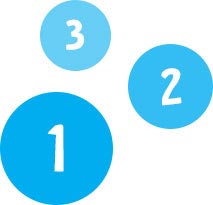
Were you expecting that it’s more complex than that? It’s really not. I think a good teacher makes “difficult” things simple, and that’s what I’m trying to do here. So, we are really talking about a step-by-step, sequential learning process. We first learn the chords, then we learn progressions, then we finally learn complete songs. In other words, you can’t learn to play chord progressions until you can play your basic chords; we have to go step-by-step.
Do you know that many songs use
the same basic chords.
Forget about having to learn hundreds of chords, because that’s totally unnecessary when you’re first getting started. What you will find is that the same basic chords are used over and over in almost every song. Yes, there are some exotic chords here and there, but most parts of most rock songs are pretty basic.
For example:
“Heart of Gold” by Neil Young starts off with a riff that goes from the E minor to the D chord.
“Jane Says” by Jane’s Addiction is G to A for most of the song.
“Knocking on Heaven’s Door” by Bob Dylan mostly uses G, D, and A minor.
“Learning to Fly” by Tom Petty is F, C, A minor, and G.
“Sweet Home Alabama is “D,C G”.
“The Joker” by Steve Miller is G, C, D.
“Get off My Cloud” by the Rolling Stones is E, A, B
“Back in Black” by AC/DC is E,D,A
“Hey Joe” by Jimi Hendrix is C, G, D, A, E.
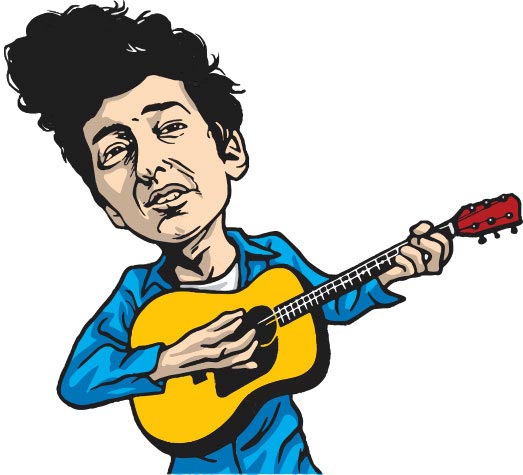
There’s endless examples…and I’m going to teach you how to play some of these songs in detail on this page — and also you should watch the webinar video below because the video instruction will make it more clear as well.
Quick tips for choosing the best guitar for beginners
But before we even get started learning a chord, let’s talk about your guitar. You want to have a nice sounding instrument. If you’re using a dusty old guitar from the basement, that may or may not have intonation problems, don’t expect it to sound good. You want an instrument that is not damaged in any way. If you do have an old instrument, you can take it to the local music shop and see what they say about it’s condition.
If you’re buying a new instrument, you don’t necessarily have to spend a lot of money. It also doesn’t really matter whether you start on the electric or the acoustic. Each have their own challenges.
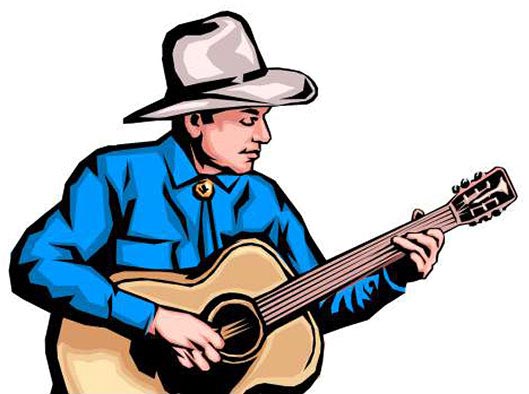
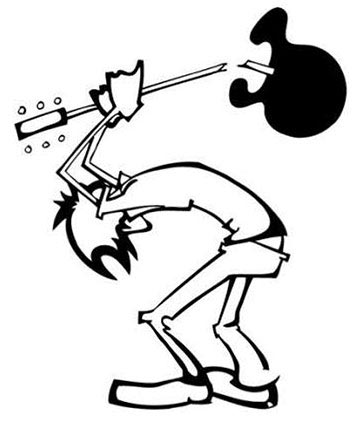
The electric is physically easier because you don’t have to push down as hard on the strings. However, it is more difficult to get a good tone out of because there’s lots of settings on the guitar and the amplifier. It really depends on your tastes, but if I had to recommend one, I’d say start on the acoustic guitar because its easier to get a good tone out of it.
When guitar players talk about “tone”, they are referring to the actual sound coming out of your instrument. This is very important. Why? Because you can be the best guitarist in the world, but if your tone is bad, its going to sound bad. The actual tone that you get is a big component in sounding good. That doesn’t mean you have to go out and buy a $2000 guitar.
Fortunately, today it is more affordable than ever to get a decent sounding guitar, but you should be aware of this. Another very important part of your tone is your guitar strings. Make sure you have fresh strings. Changing your strings often can be a pain in the arse, but its worth it. Old strings lose their intonation and start sounding bad. I would suggest changing your strings maybe once every 4 to 8 weeks or so, depending on how much you play.
Basic Instructions: How To Tune A Guitar
When you play, make sure that you’re in tune as well. Get an electronic tuner or pitch pipe. A pitch pipe forces you to use your ear to help tune, while an electronic tuner takes the human factor out of the equation. The electronic tuner method of tuning is the best in the beginning because it takes the guesswork away, and you KNOW you’re in tune. After you get a little experience, its good to use a pitch pipe because it will help your ear.
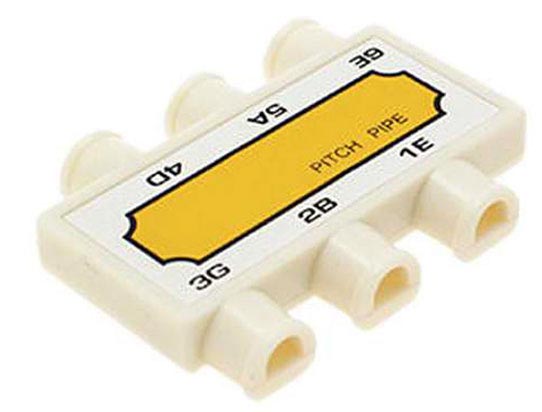

Sometimes, guitarists are confused by the terms “LOW and HIGH” when referring to strings and notes. The “LOW” E is the heaviest string, the most “bass” sounding note on the guitar. Even though the low E is the “highest” in physical location – it is closer to the ceiling while the high E is actually “lower”, closest to the floor.Don’t get confused. Low means low frequency.
Please be careful if you’re new to this. Too much tension can be dangerous to the guitar neck, so make sure you have the right strings on your guitar, make sure you’re tuning to the right pitch, and check with your local music store if you’re in doubt.
How to Hold a Guitar: Proper Posture and Hand Positioning
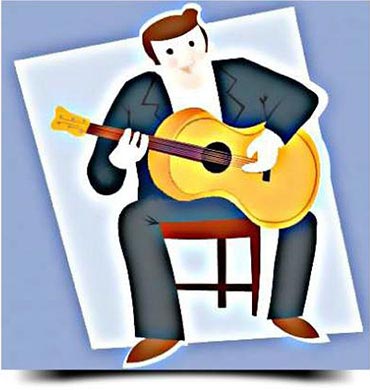
If you’ve got an acoustic guitar, sit down in a comfortable chair and rest the guitar in your lap with the body of the guitar close to you. The neck of the guitar should be pointing toward your left. If you have an electric, you may choose to stand up and play with a strap. If you do, don’t hang the guitar too low so its difficult to play.
With your left hand, you can hold down some of the strings on the fretboard, and with the right hand, you can use a guitar pick to play the strings. To hold the pick, you grasp it firmly (but without excessive tension) between your thumb and first finger.
The small pieces of metal running up and down the neck of the guitar are called frets. When guitarists talking about playing something “At the 7th fret”, for example, what they really mean is to place your finger on the fretboard just behind the 7th fret, but not touching it. There’s usually 22 or 24 frets on an electric guitar and maybe 17 frets or so on an acoustic. The lowest fret you can play is the first fret. Of course, you can also play a string without fretting it at all. This is called playing the string “open”.
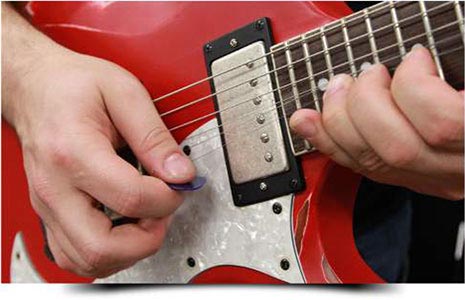
Your First Chord: E Minor
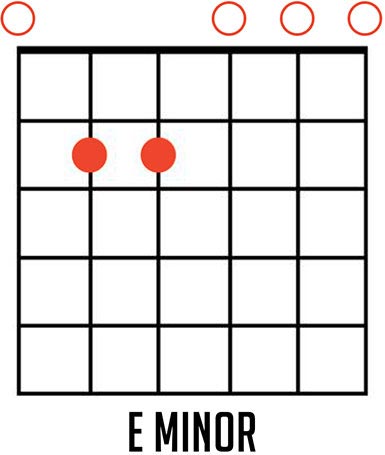
Now that you know what the names of the strings are, and what the frets are, you should be able to play your first chord: E minor. Place your middle finger on the 2nd fret (just behind the fret) on the A string, and your ring finger on the 2nd fret on the D string. Then use your pick to strum all 6 strings.
If you’re going to be a guitarist, you have to get used to reading chord diagrams. Here’s the E minor shown in a diagram:
Let’s examine this diagram. The first thing that’s important to know is that the low E string is shown on the left, and the high E string is on the right. Imagine a guitar is placed propped up against the wall, facing you. Well, the low E string would be on the left side, wouldn’t it?
So, this is the same layout for the chord diagrams.
You will see a few red circles and a few red solid dots. These are not usually drawn in red; I just did that so the picture is easier to see.
The solid dots are where to place your fingers. Notice the 2nd fret on the A string and D string have dots. The circles above the other strings indicate that the string is to be played open. In this case, we are playing all 6 strings. If a string is not to be played, there is usually an “x” above the string, or nothing at all.
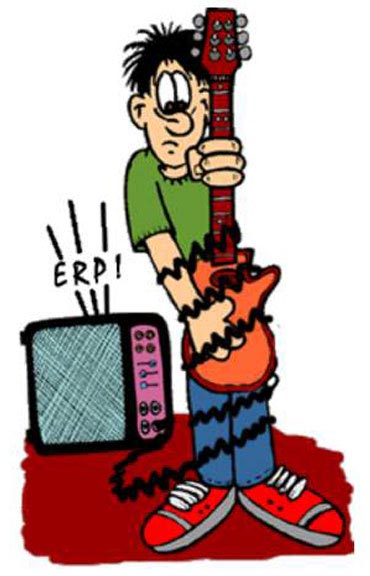
3 common beginner mistakes when learning how to play easy guitar songs
If you can play an E minor chord successfully, then you are well on your way. If you did, give yourself a well-deserved pat on the back. If it doesn’t sound good, then you may be making one of several common mistakes.
Mistake #1: Your Guitar is Broken or Not in Tune.
This is an obvious one, but should be mentioned. You can’t expect to sound good if you’re out of tune or if your guitar itself has an intonation problem or fret buzz going on.
Mistake #2: You are not pressing down hard enough with your fingers.
Guitarists who have been playing for a little while make it look easy, and it DOES become easy after a bit. But in the beginning, you may not be used to the pressure that is needed to push down hard on the fretboard.
Mistake #3: You are Muffling the Other Strings.
Ok, so you are playing the notes correctly that you are fretting, but are the other strings that are supposed to be ringing open actually ringing clearly? You may be muting them accidentally with your left hand palm.
These are the three biggest mistakes.
Correcting Your Mistakes
First of all, how do you really know if you’re playing the chord correctly? The best way is to do what I call a “ring test”, and that means to play each string individually and make sure it is sounding good.
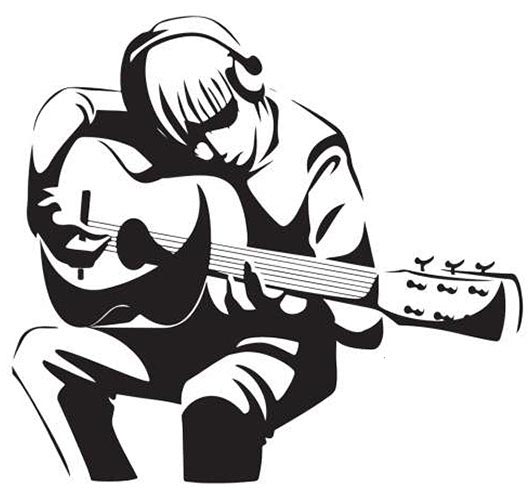
When all the strings are sounding good, then the chord as a whole will sound good. Also, if you are muffling the strings, a good technique to do is to really arch your arm away from the guitar in what I call the “bowling ball” grip. Imagine you are holding a bowling ball. Notice the way the entire arm is curved. You want a nice curvature of the arm so that the palm doesn’t muffle the other strings.
Also, when you are playing the chord, you want to use a nice “downstroke” with the right hand. Start by playing the low E and continue all the way through the high E with one solid motion.
Your Grab-bag of Chords
Remember, we are learning step by step here. So if you aren’t completely comfortable playing the E minor chord, I would suggest not going any further in this e-book. Instead, working on playing the E minor chord. Hey, if you can’t master a single chord, you’re not ready to continue.
Don’t worry if it take you a little while to get it. Just keep working on it, and get that first chord under your belt. You should learn the following chords:
1. E minor – We just learned this one.
2. G Major
Place your middle finger on the 3rd fret low E string, your first finger on the 2nd fret on the A string, and your ring finger on the 3rd fret high E string. Then, play all 6 strings. This is slightly more difficult than the E minor chord.
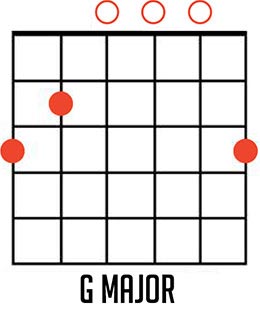
3. C Major
Place your ring finger on the 3rd fret A string, your middle finger on the 2nd fret D string, and your first finger on the first fret B string. This chord is different than the G major and E minor chords because you are ONLY playing the top 5 strings. Do not play the low E here. Start your pick on the A string and strum down. Notice the X on the chord diagram that indicates you shouldn’t play the low E.
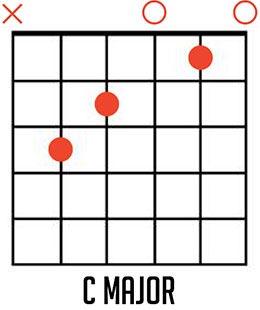
4. D Major
Place your first finger on the 2nd fret G string, your ring finger on the 3rd fret B string, and the middle finger on the 2nd fret high E string. The D string rings open and the A string and low E string are not played.
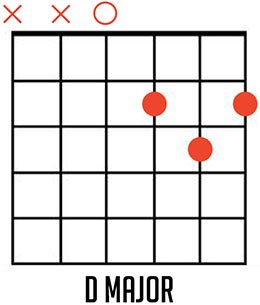
5. E Major
This is very similar to the E minor, but you are adding one more finger.
Place your middle finger on the 2nd fret on the A string, your ring finger on the 2nd fret on the D string, and add the first finger to the first fret G string.
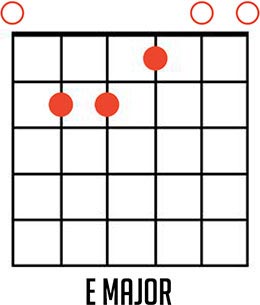
6. A Major
The difficulty level rises slightly again, so make sure you can play the previous chords before trying the A major chord.
There’s two ways to finger this chord. The first way, is to place your first finger on the 2nd fret D string, the middle finger on the 2nd fret G string, and the ring finger on the 2nd fret B string.
The second more common way, (but possibly slightly more difficult for the beginner) is to use your first finger to hold down all three notes.
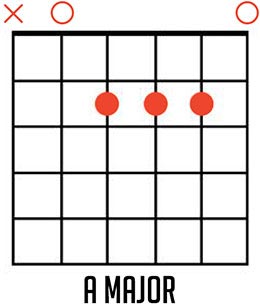
7. A Minor
Place your middle finger on the 2nd fret D string, ring finger on the 2nd fret G string, and first finger on the first fret B string. On this chord, the A string and high E are ringing open and the low E is not played.
This completes your beginning chord grab bag. With these 7 chords, you are well on your way to mastering the guitar. Sure, there are other chords you need to know, but for now, focus on mastering these.
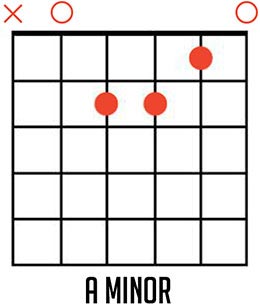
How to Play Songs on Guitar: Switching Between Chords
Can you play all 7 of the chords I showed you above? If so, congrats! You’re making excellent progress and you’re ready for the next step. If not, please master those 7 chords before continuing.
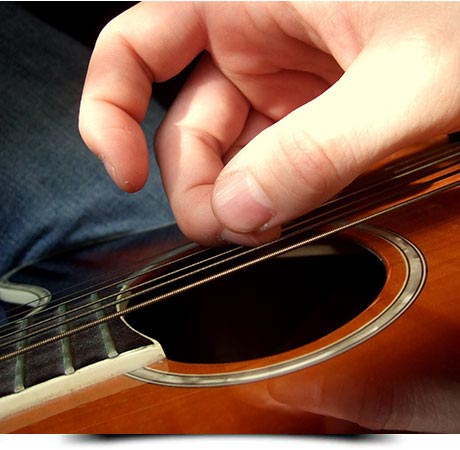
Now, the next step is to learn to switch between the chords quickly, almost instantly. This will be hard to do at first, but becomes easy after some practice. Do not worry about the rhythm for now. Just learn to switch back and forth quickly between any of the chords.
This is often where beginner guitarists give up, because they don’t realize just how close they are to success. Actually, most struggling guitarists do not even understand that the goal at this point is simply to become comfortable switching. The mistake is to try to jump right into playing a song. Do not do that. In fact, don’t even worry about strumming technique or playing in rhythm at all.
That’s right — you should ignore strumming and rhythm until you are comfortable switching chords. You need to isolate these movements and focus 100% of your attention on this obstacle.
Here’s what you do: Pick any two chords. Doesn’t matter which ones. Now just practice switching between them. For example, Em and D. Play the Em chord. Then play the D chord. Then back to the Em, etc. That’s all you’re going to do for several minutes. Again, do not worry about rhythm and do not worry about sounding good except to make sure the chords themselves are being fretted and played correctly.
A few tips: It’s good to get the blood flowing in your fingers. You can do a few simple exercises like making a fist, then opening your fingers fully (do this a few times). You can also place your palms flat together and slightly bend your wrists back and forth. This is not essential but you want to be feeling limber. Stiffness is not good. So “think loose” and be loose.
If you feel you are “getting lost” when going from one chord to the next, isolate it even further by focusing on each finger. For example, when playing an Em chord, your middle finger is on the second fret of the A string. If you’re switching to a D chord, now that same finger goes to the second fret of the high E string. So pay attention to where each finger is going. Take your time. Do not allow yourself to feel overwhelmed.
Once you get the movement into your nervous system of going from one chord to another chord, just repeat it and it will start to become ingrained in your muscle memory.

Once you get the ‘back and forth’ going, gradually speed it up so that you’re able to go between the chords FAST. Also very important is the amount of time you are spending doing this little drill with two chords. I would suggest you do this “back and forth drill” for 3-5 minutes. You can go slightly longer if you wish but the body and the nervous system needs time to recover and “absorb” what you’re trying to teach it. If you do the drill for a few minutes then take a break and come back, it will feel easier the next time. (It’s just like doing sets and reps at the gym: You usually need a rest between sets.)
You can really make a ton of progress in a single day by simply having a lot of mini practice sessions. If you really are inspired to learn the guitar as fast as possible, do this: Set your timer for 3 minute intervals. Do 3 minutes on, 3 minutes off. You can get in 10 “mini sessions” in an hour.
Learn to Play Guitar Songs: Playing in Rhythm
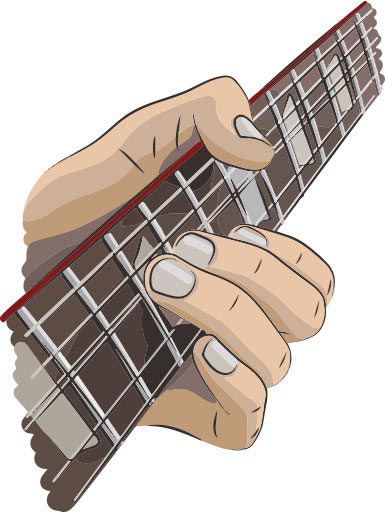
This is a really important step. Even though we’ve already now conquered the main task at hand of “chord switching”, we want
to start making some real music as fast as possible. Nothing breeds confidence and motivation like RESULTS and when we can actually switch chords and play in rhythm too, now we are making music and we will hear it, feel it, and enjoy it.
So, the basic idea here is just to count “ONE.. TWO… THREE… FOUR…”. Start with just two chords (for example Em and G). Strum the Em chord on each beat: “ONE… TWO… THREE… FOUR…”, then switch to the G and strum it four times as well, keeping a steady pulse: “ONE…TWO…THREE..FOUR…”. Then go back to the Em and keep repeating the pattern.
Again, you should have already mastered the switching before you try this, so now you’re free to focus on the rhythm. Isn’t this fun? 🙂 Congrats! You’re playing guitar! Don’t be afraid to go really slow at first.
Also, do not worry about trying to do an instant hyper fast chord switch. The reality is that guitarists are human beings, not super robots and there is always going to be some delay in switching from one chord to the next. There is a natural “gap” in time from when your fingers come off the first chord and land on the next chord. This is ok because the guitar is still going to be ringing. However, you want to time it so that your fingers are in place for the next count of “ONE”. That means you’re going to be moving off the chord near the end of the fourth beat so you can be ready to play a new chord on beat one. Hope that makes sense.
When you are strumming this first basic pattern, you should be using a downstroke on all four beats, which means your pick should be moving downwards towards the floor, hitting the low E string first and then raking across the strings to the high E string.
The next step is to strum the chord twice as many times by counting like this:

On this variation, you should be using a downstroke on the “one”, “two”, “three” and “four” and an UPSTROKE on the “AND”s. So, you will be strumming down, up, down, up, down, up, down, up.
On the upstrokes, do not worry about hitting all the strings of the chord. Just make sure to get the high E string and a couple of other strings.
How to Play Simple Complete Songs on Guitar
What is a song really?
A song is made up of several sections, and each section is really a chord progression. For example, a song may have a verse section, a chorus section, perhaps a “bridge” section, possibly an intro section, etc.
In addition to each section that is composed of a chordal progression, there is usually a melody that is played over the chords. Most often, the melody is a vocal melody.It is the interplay/harmony between the vocal melody and the underlying chords that gives a song its recognizable, unique quality.
So, how do we learn simple guitar songs? First, we should have a recording of the song and listen to it, in order to familiarize ourselves with that song, if we have not already.
Next, we have to identify the chords of the song. Most beginners cannot do this by ear, so it helps to have a song book, or often you can do a google search.
The only problem with stuff you find online is there a shocking amount of errors. The best way is to use a premium resource like
In any case, you will want to listen carefully to the song and pick which parts you are going to play and which parts you are going to leave out. For example, a song may have a long instrumental introduction that doesn’t make sense for you to try to play.
Keep in mind that when are you are starting to play songs on your own, on the guitar, you are somewhat limited and so not every part of every song is going to make sense.
Often, you have to use a little common sense, and pick and choose which parts make sense, based on the song and your current skill level.After choosing the parts you want to include in your own arrangement, you then learn the chord progression of each section separately and make sure you can master each part.
The next step is to learn to sing the melody (at least on a basic level) Remember, a song consists not merely of chord progressions, but also of vocal melodies. So, to just play the chords without the vocal melody is not really going to capture the essence of the song.Often, it is the vocals which are the most prominent and recognizable part of the song, and the chords are really just backing that up. Don’t worry if you’re not a good vocalist. That hardly matters when you just want to play your songs in a casual setting.
Even humming the melody is ok sometimes. You might discover that you are better than you thought. Plus, when it comes time to perform in a real setting, you can find a lead vocalist to accompany you if you really don’t want to sing.
Make sure you print out a copy of the lyrics and memorize them. That’s often where people get stuck on songs – they learn the chord progressions and then forget the vocals!
Sure, memorizing the lyrics is another step, but you’d be amazed how powerful that is, to actually know all the words to the song. Then, a simple chord progression comes to life, almost like magic.
“Learning to Fly” by Tom Petty

Again, I recommend you watch the video here on this page because a picture says 1000 words and a video says a million.
This song has the chords F, C, A minor, and G. Remember, going back to basics we want to make sure we know the chords first, that’s step one, right?
Now, this F chord, you may not know. That’s not one of the seven that I showed you. Instead of playing a full F barre chord, you can do this shape:
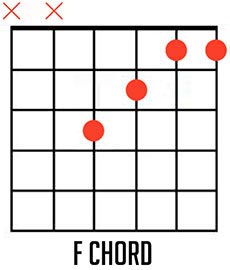
What I’m doing here is I’m using my first finger to barre the top two strings on the first fret and then my middle finger is on the G string, 2nd fret and ring finger on the 3rd fret, D string.
This is a simple start for learning how to play easy guitar songs.
Now let’s talk about strum patterns…
The strum patterns are VERY important. They’re kind of what make the rhythm go together with the chords. Once you get down the very basic “ONE TWO THREE FOUR” that we talked about earlier, you will want to spice things up just a bit.There are always two ways to learn a strum pattern. One is just by ear. So if you just want to copy what I’m doing in the video. You can hum that and just kind of follow along.
The other way is to count it out.
For this song, you count the rhythm as: “One and Two ANNNND and Four and”, where the “and” of the second beat is stretched out.
Remember that when you are strumming “one and two and three and four and”, the downstrokes go to on the numbers and the upstrokes go on the “ands”.
So on this stretched out beat, you are still playing an upstroke, but it’s just held longer. Then, you don’t say the “three” or strum down, and then you do another upstroke on the “and” of three.
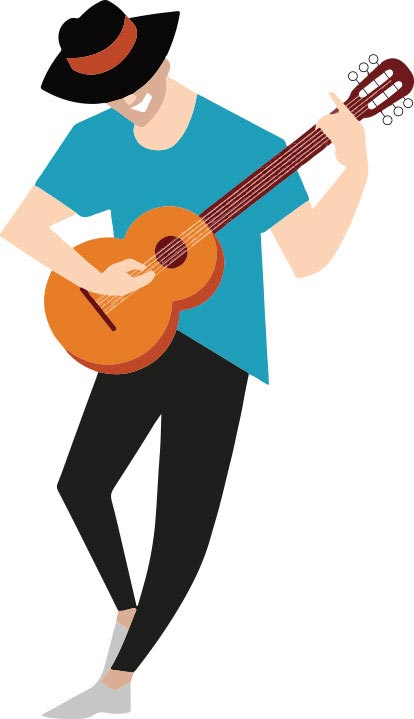
When you switch chords from the F to the C, you do it on that long “and”. Same thing on the A minor to G. Let’s put it all together, slowly. Let’s speed it up a little bit.So, please watch the video to see exactly what I’m talking about here.
Don’t forget to add the vocals, and you don’t have to be a great vocalist because when you sing a little bit of the melody it really ties the song together.
“Hey Joe” by Jimi Hendrix
Here’s the chord progression for this tune:: C, G, D, A and then four bars of E.
The strum pattern on this one can best be described as playing on the “ones” and the “threes”. So, if you count : one, two, three, four, you just play on the beat one and three.
There’s also something called a pick-up note, which I’m also doing what’s called a little pick-up note which is basically like the second half of beat four, which is the “and” after four. On this beat, you’ll be starting the next chord early (see the video).
There’s other parts of this song like the intro that Hendrix plays, but you really don’t need this. This is what I mean when I talk about arrangements. If you just show up at a party and you just start playing… Everyone is going to be vibing with it. No one will say “Stop..hey, you didn’t play the intro.”
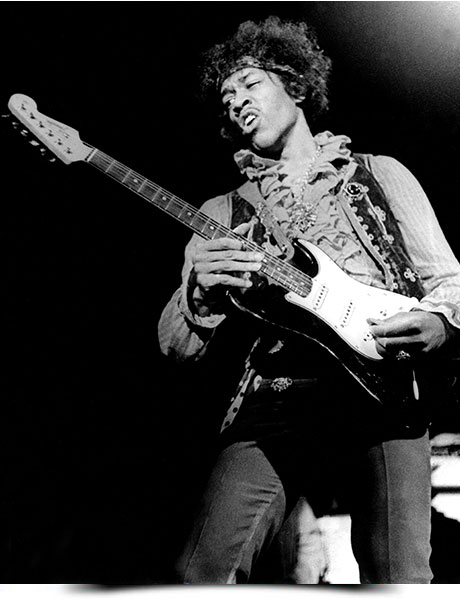
“Fly Away” by Lenny Kravitz.

Let’s talk about one more song here. This one is going to be A, C, G to D.
This song is a little bit more complicated than the other ones just because we’re going to have two different strum feels. Some songs have different chords for the verse and the chorus and I purposely picked songs here that are really simple and straight forward just to show you how easy it can be to put a song together.
But when you have a more complicated song it’s actually not always more complicated, it just seems more complicated. Really, it’s just learning like one part and then learning another part and then playing them back-to-back. In this song, we have two different parts. Each part really has the same chords, but different strum patterns.
On the verse it would be that same thing we just learned, the one and the three. (Actually, in reality, the bass guitar is driving that song, but this is how I would arrange it or approximate it).
When it goes to the chorus it’s more of a “one, two-and, three-and”. Please watch the video to see what I mean.
How to Play Your Favorite Songs Webinar
Below is a webinar I gave not too long ago, covering everything I’m talking about here. It should make everything 100% crystal clear that I’m describing here, especially the rhythms and strums on these songs.
Learning How to Play Guitar Songs: Conclusion
I hope this page helps you easily learn how to play songs on guitar. It really is not as hard as you might think. Don’t be intimidated. Just take it step by step, and try to practice a little bit each and every day. Consistency is king and you will be making tremendous progress if you follow my plan here. Bookmark this page and re-read it often as you get started on your guitar journey.
Once you get a little bit of confidence, you may also be interested in checking out my Ultimate Guitar Song Collection where I’ve done all the research on hundreds of songs and this will be another big shortcut to building up your own personal repertoire.
